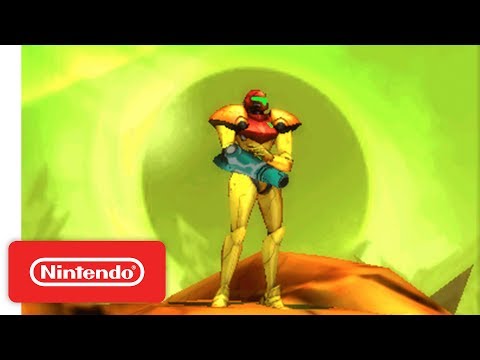There’s a looming shadow hurting the name. A wide lineup of developers is behind the different franchise entries. Rivaling ideas means radical deviations from the original formula that popularized these games.Although it started as a 2D non-linear side-scroller, Metroid evolved into a familiar first-person sci-fi adventure. That’s until Metroid Dread, at least, so we’re inclined to check the whole journey of the series.
The Metroid Series
The Japanese action-adventure game series introduced one of the most iconic female characters in the industry. It’s Samus Aran, a bounty hunter protecting the galaxy from parasitic Metroid creatures. Also, she can harvest the Metroid power for her suit to develop new skills.But the name is not exactly because of the enemies. The Nintendo IP mixed “metro” (the transport) and “android” to describe the settings. Metroid games happen in underground futuristic scenarios. Moreover, the titular character wears a robotic suit. Also, I should note the Metroid creatures are not always present. There’re other hostile aliens and parasitic races across the entries.The design of Metroid games is influential even today. Titles that follow similar designs belong to the “Metroidvania” category. An example is the Castlevania games.Metroidvania started on the first entry when Metroid was 2D. It means the game is linear but open-ended. There’s a single map to explore, and you have the freedom to go anywhere, in theory. However, you need to find weapons, skills, or items to unlock certain areas.There’s a great emphasis on exploration and environmental storytelling along the journey. Games like The Legend of Zelda follow these ideas as well. Then, the gameplay relies on platforming, exploration, and battle against hostile aliens. Samus gets power-ups necessary to thrive in isolated, sci-fi atmospheres.That said, the traditional games are 2D side-scrolling titles. Further down the line, the Metroid Prime series became 3D first-person titles.The Nintendo Research & Development 1 team started creating the first Metroid game around 1984. They released Metroid a Kid Icarus in 1986 as “sibling games.”Kid Icarus ended in 2012, after three games. On compassion, Nintendo has released 15 Metroid games since the beginning. That’s ten core games, two spin-offs, two remakes, and one bundle.
Every Metroid Game by Release Date
Metroid – 1986
The original Metroid game debuted in 1986 for the Japanese Famicom. A year later, Nintendo released the title worldwide for the NES.Notably, Intelligent Systems worked alongside Nintendo R&D1 for the title. Intelligent Systems are also creators of the Fire Emblem series, another significant Nintendo franchise.The game follows Samus as she journeys to retrieve the Metroid organism from Space Pirates. The Pirates want to turn the parasites into biological weapons to destroy Samus and other enemies.It was a basic 2D side-scroller, “Metroidvania.” Samus plays within a large underground later. She can jump, shoot, crawl (as a ball), and gather power-ups.
Metroid II: Return of Samus – 1991
Return of Samus debuted for the Game Boy in 1991 (Japana) and 1992 (Europe and North America).Samus Aran continues her mission to erase the Metroids from her home planet (SR388). However, she’s on a race against the Space Pirates, craving to harvest the parasite power for themselves.The game follows the original formula but adds several staple elements. It includes Samus’ Varia Suit, the Spazer Beam, the Spider Ball, and the Space Jump.
Super Metroid – 1994
Super Metroid debuted in 1994 for the Super Nintendo.Samus Aran travels to Zebes to retrieve an infant Metroid parasite. The Space Pirates, and their leader Ridley, captured the young creature.The title follows the established formula of Metroid II. Also, it adds an inventory screen, an automap, and the ability to fire in all directions.
Metroid Fusion – 2002
Metroid Fusion debuted in 2002 for Game Boy Advance. It’s the last classic main entry before the “Prime” sub-series changed the formula.The titular bounty hunter is exploring a space station infested by shapeshifting parasites. She knows the race as “X.”Like previous entries, Fusion is a 2D side-scroller with platforming, puzzles, and shooting. Also, it introduces missions that guide players across the map.
Metroid Prime – 2002
Metroid Prime debuted in 2002 for GameCube, a day before Metroid Fusion. It’s the first 3D entry in the franchise, so the game turned into a first-person shooter.The story happens between the first and the second title. Samus Aran battles against the Space Pirates to destroy their biological experiments on Tallon IV.Still, the game retains its focus on exploration, so Nintendo named it a “first-person adventure.” Samus travels across the planet, searching for twelve artifacts to open up the last area, a meteorite.The gameplay involves exploration, unlocking power-ups, finding key items, solving puzzles, and jumping platforms. Then, the shooting revolves around “lock-on” mechanics that allow Samus to fire in all directions.
Metroid: Zero Mission – 2004 (remake)
Zero Missions debuted in 2004 for Game Boy Advance. It’s the last Metroid Game by Nintendo R&D1. Instead, Retro Studios took the lead.The game is a remake of the 1986 Metroid game. The 2D gameplay has updated visuals and upgraded mechanics. The story is the same, but it explores Samus’ backstory as a novelty.
Metroid Prime 2: Echoes – 2004
Retro Studios’ Echoes debuted in 2002 for the Nintendo GameCube. It’s the first Metroid game with a multiplayer shooting feature. Also, it debuted in North America in 2005 as “Metroid Prime 2: Dark Echoes.”Samus’ goal is rescuing Galactic Federation Marines from a ship inhabited by the Luminoth race. She discovers a new enemy, the Ing, a hostile race from an alternate dimension.So, Samus travels to four temples to destroy the Ing. In the meantime, her alternate self, Dark Samus, becomes her greatest enemy.The title has a heavy focus on storytelling and new mechanics. In essence, players need to explore both dimensions to find necessary power-ups and items. Also, there’re new skills, new beam weapons, and limited ammo.
Metroid Prime Pinball – 2005 (spin-off)
The pinball video game debuted for Nintendo DS in 2005 (Australia) before reaching Japan, Europe, and North America.Fuse Games created the spin-off, and it’s simply a Pinball game with a Metroid thematic.
Metroid Prime Hunters – 2006
Hunters debuted for the Nintendo DS in 2006. It’s a Redmond game, a Nintendo Software Technology subsidiary. As the previous Prime entry, it includes a competitive multiplayer feature.The story follows events between Prime and Prime 2. Samus Aran is investigating a message that came from the Alembic Cluster. On the far-away Solar System, she allies with other bounty hunters to search for a mysterious power.This title leans more into the first-person shooting mechanics. There’re new weapons and the ability to travel to different planets with Samu’s gunship. Also, the game had a multiplayer feature via Wi-Fi and with voice-chat.
Metroid Prime 3: Corruption – 2007
Corruption, also by Retro Studios, debuted for Nintendo Wii in 2007. Unlike the previous games, it reached North America and Europe before Japan.The story happens six months after Prime 2. Samus Aran is defending the Galactic Federation from a Space Pirate attack in the Norion naval base. During the mission, Dark Samus attacks her fellow bounty hunters. She soon discovers her alternate self released a dangerous virus on the planet.As a Nintendo Wii game, the gameplay comes through the Nunchuk remotes. Players can use the controllers for jumping, firing, aiming, and performing other attacks and abilities. Also, Corruption introduces the ability to use powerful attacks and command her gunship.Lastly, as in the previous game, Samus can use her ship to move to other areas.
Metroid Prime: Trilogy – 2009 (bundle)
In 2009, Nintendo released a bundle of the Prime Trilogy for the Wii console.The collection packs Metroid Prime, Metroid Prime 2, and Metroid Prime 3. The first two games debuted for GameCube. So, Retro Studios updated the controller scheme to fit the Wii’s Nunchuk.
Metroid: Other M – 2010
Other M is a 2010 game for the Nintendo Wii. Team Ninja and Nintendo SPD are behind the title. Samus Aran is researching a derelict Galactic Federation space station. A Marine platoon joined her on the quest.The title came with a heavy focus on characterization, voice acting, and cinematics. For example, after completing the game, players can unlock a “Theater Mode,” a two-hour presentation with all the in-game cinematics.It significantly changed the title by delivering smaller character models and a front-facing camera. However, the camera swaps to first-person (Samus’ HUD) for some skills and segments. Either way, gameplay includes combat, exploration, platforming, puzzles, and the novelty of melee attacks.
Metroid Prime: Federation Force – 2016 (spin-off)
Federation Force is a co-op first-spin-off. After a six-year hiatus, Next Level Games released it for the Nintendo 3DS.The story happens after Prime 3. Players control Galactic Federation Marines fighting against Space Pirates.Without Samus, the game relies on first-person shooting mechanics and its multiplayer co-op campaign.
Metroid: Samus Returns – 2017 (remake)
Another set of developers entered the scene for Samus Returns. MercurySteam and Nintendo EPD created the 2017 entry for Nintendo 3DS.This is a remake of Metroid II: Return of Samus. While the structure and story are faithful to the original take, the developers remade the graphics, interface, character models, animations, and controllers.Also, while the game is in 2D, there’re new mechanics. For example, Samus has a melee counterattack and can aim freely anywhere. Also, it adds 3D backgrounds, cinematics, animations, and character models.
Metroid Dread – 2021
Metroid Dread debuted in October 2021 for Nintendo Switch. MercurySteam and Nintendo EPD took care of the newer title.Samus Aran returns to the classic 2D side-scroller. The game adds stealth elements, 3D visuals, and several mechanics to update the franchise.As for the plot, the story happens after Metroid Fusion. The X parasite species came back, and they can mimic any creature. A dangerous enemy traps Samus deep underground to exterminate the creatures. Without her suit and most of her abilities, she must find a way out and destroy the X.The gameplay is about exploring the ZDR planet in a side-scrolling action-adventure style. Players discover items, weapons, and power-ups to unlock areas and defeat enemies. Dread also adds stealth mechanics. She learns a camouflage skill (Phantom CLoak) that makes her invisible. Another notable new ability is dashing. Lastly, Dread is highly regarded as the most challenging game in the series. It’s also one of the hardest games of the year. Also, it won the “Best action-adventure game” in 2021’s GoTY awards.
Every Metroid Game in Chronological Order
Will the Metroid series continue?
Back in 2017, Nintendo released a teaser for Metroid Prime 4. It’s expected for 2022.
















